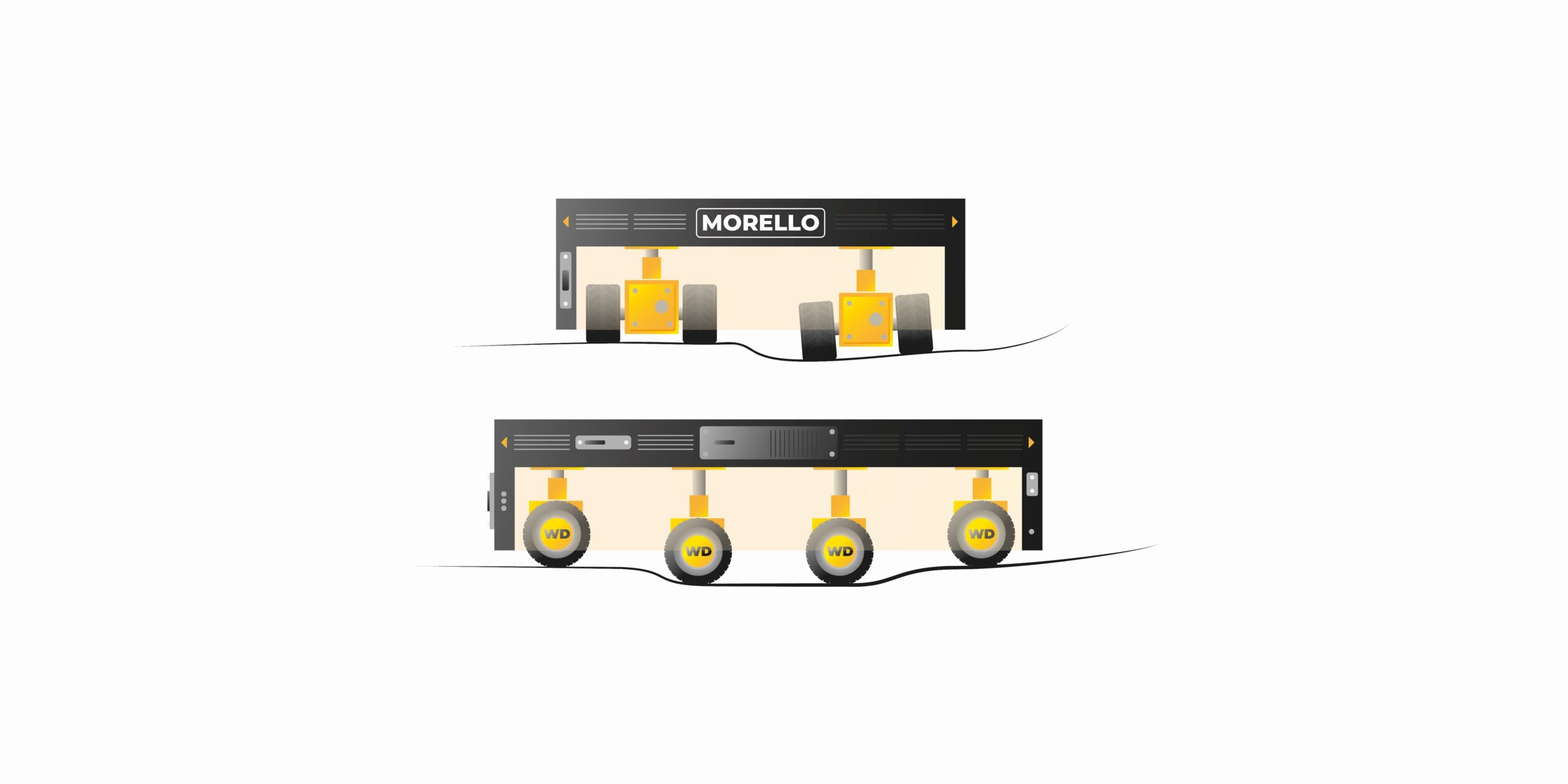There are numerous omnidirectional steering systems on the market allowing motorised carts to move in all directions and perform special steering actions like the carousel (steering around its own centre), the compass (steering around a point), crab steering, etc.
Morello’s OMNI machines are fitted with a system resulting from years of study, field testing and customer feedback analysis.
Compared to other, less advanced systems, our system:
- Does not damage the Plant’s flooring, avoiding the high cost of continuous repairs
- Prevents premature wheels wear, reducing relative maintenance costs
- Can also work on imperfect flooring, thus saving on the cost of floors adaptation
- Is extremely flexible and future-proof; it can be moved between production departments or Plants with different types of flooring
- It ensures a strong grip on all types of flooring, even if sloping or wet, avoiding cart “stoppages” and subsequent downtime
- It allows extremely precise driving, optimising handling times
- It is almost maintenance-free since it is powered by brushless electric motors
- It has low battery consumption, resulting in considerable economic savings during use
- It has a very flexible lifting system that can handle any type of load
But how is it technically different to other systems?
ALL THE WHEELS ARE DRIVEN
Every single wheel has its own brushless electric traction motor controlled by its own inverter.
All the wheels are therefore electronically controlled (direction, acceleration, revolutions, torque, etc.) by our software. This means there are no trailer wheels that, if not controlled, would be “dragged” and risk ruining the flooring on which they are used.
The Morello all-wheel drive system also ensures a perfect grip on all types of flooring, even if sloping or wet, thus preventing frustrating cart “stoppages” caused by small holes, sudden slopes or any unexpected uneven surfaces. In which case, a large crane or other means would be needed to solve the problem.
THE WHEELS ARE CONNECTED IN SETS OF TWO AND STEER AROUND THE CENTRELINE
None of the wheels rotate around their own axis or too close to it, thus avoiding “slippage” during steering. Slippage that:
- Permanently ruins the wheels and flooring
- Significantly reduces the vehicle’s steering precision, especially when stopped (not moving). Causes uncontrolled movements of the entire system that may make it difficult for the operator to precisely position the cart
THE PAIRS OF WHEELS THAT OSCILLATE ON A TILTING AXLE ARE SUPPORTED BY A HYDRAULIC SUSPENSION CYLINDER USED TO BOTH BALANCE THE WEIGHT ON THE WHEELS AND LIFT THE LOADING BED (IN VEHICLES WITH LIFTING)
This hydraulic compensation means the vehicle can be brought into a state of balance known as isostatic, with 3 points of stability, the 3 points that guarantee forming a single plane (the ground). Since the system is balanced on just 3 points:
- We know for certain that all wheels are always in contact with the flooring, even on imperfect surfaces, thus avoiding vehicle slippage and stoppages
- The weight is equally distributed across all wheels, preventing wheel overloading that can lead to excessive wear or even structural failure
Many systems on the market without this hydraulic compensation are balanced on 4 or more points! This creates a so-called hyperstatic system, an excessively “rigid” system that cannot ensure all wheels are effectively touching the ground. This, as described above, can lead to vehicle stoppages and overloading of the wheels and the entire structure, which can seriously damage the cart and the flooring on which it operates.
THE ENTIRE LOADING BED IS LIFTED VIA THE HYDRAULIC WHEEL COMPENSATION SYSTEM
The hydraulic compensation system also serves (where required) to lift the vehicle’s loading bed. By lifting the entire loading bed and not just certain beams/plates:
- The cart is much more versatile as it can be used to lift any type of load without any particular limits in terms of interfaces
- The contact surface with the load is substantially larger, resulting in improved load stability and better distribution on the cart, and therefore on the wheels and flooring
Systems that lift only certain beams/plates are far more “rigid” and risk becoming quite restrictive in the event the vehicle needs to be used for purposes other than those for which it was originally intended. Moreover, this can lead to poor distribution of the load, jeopardising its stability and the structural strength of the entire system.
Lifting with the hydraulic compensation system allows individual control of each hydraulic point, “tilting” the loading bed as needed. Something that is not possible with a “rigid” system.
ALL WHEELS ARE DRIVEN, BUT CONSUMPTION IS LOWER
Although all wheels are driven, the battery uses less power compared to other systems. In fact:
- The traction motors are also used to steer, thus reducing the power needed for steering
- Since there are no trailer wheels that slide along the floor causing friction (and ruining the wheels and flooring), and since they are all controlled by latest-generation inverters, unnecessary strain is reduced to a minimum
THERE IS ALMOST NO MAINTENANCE
By avoiding the use of hydraulic motors for traction and steering, using only brushless (maintenance-free) motors instead, maintenance and its relative costs and downtime are reduced to a bare minimum.
Visit our OMNI page or contact us directly to ask for more information!







